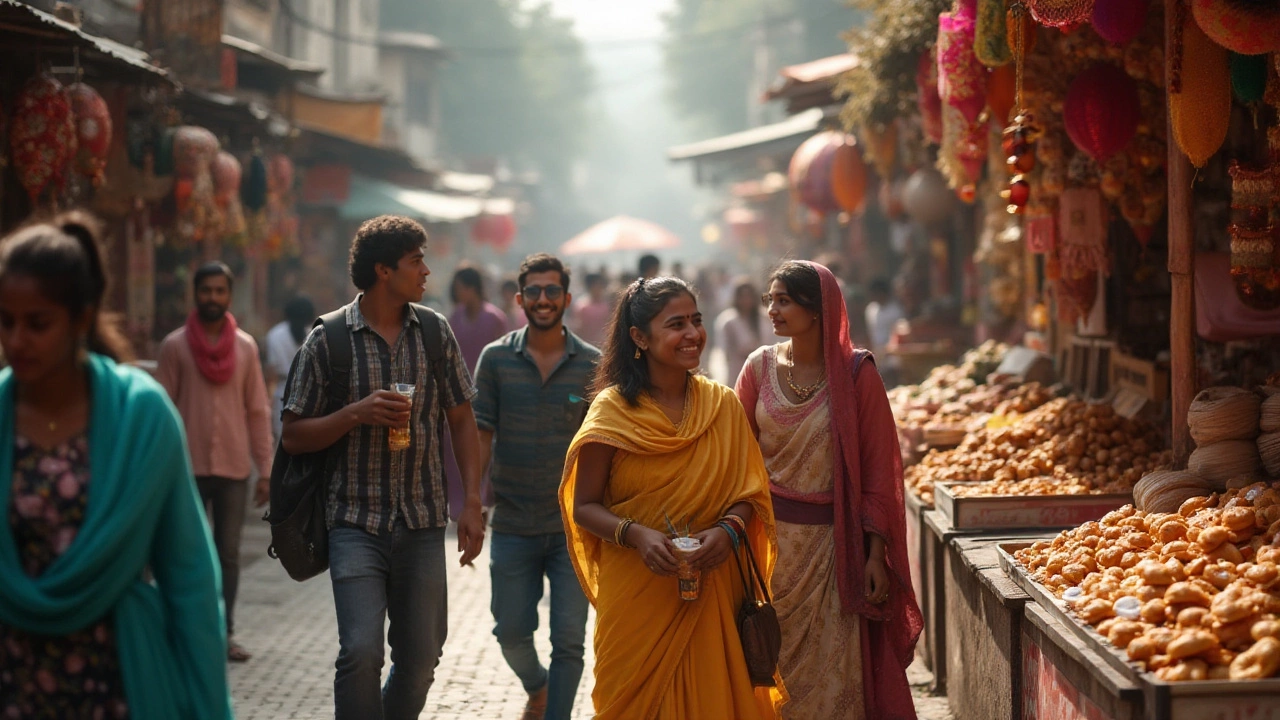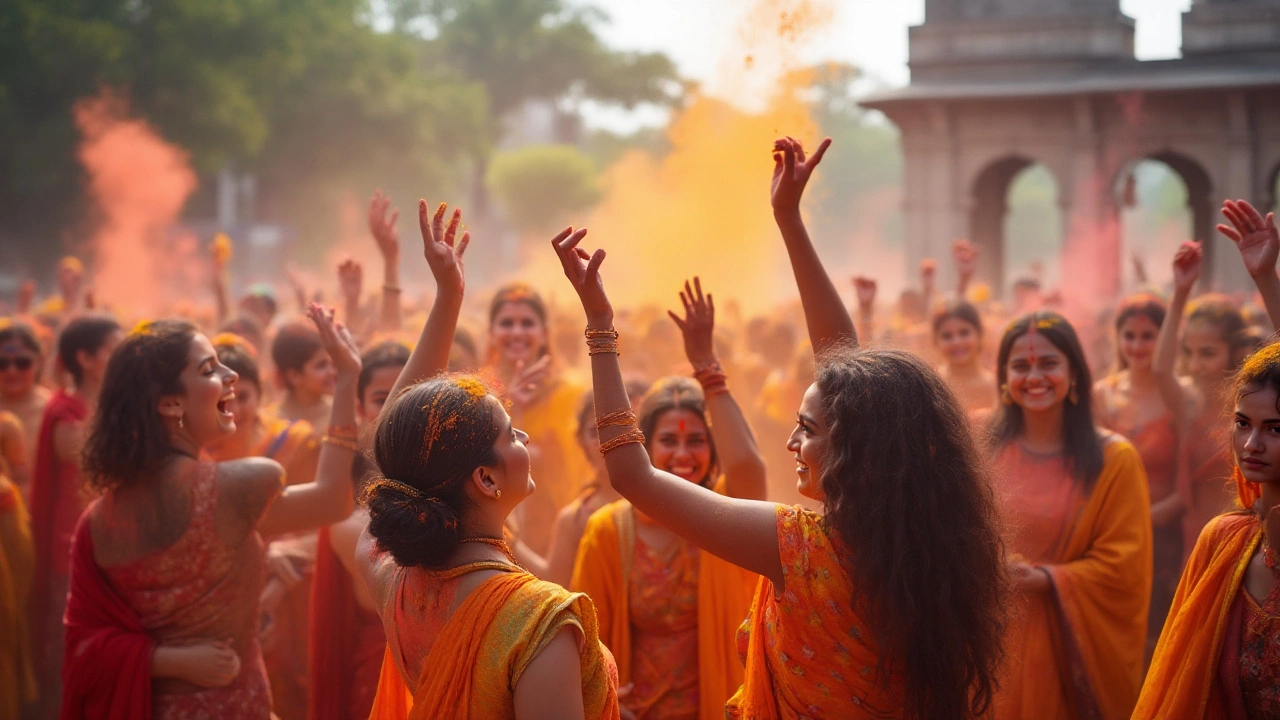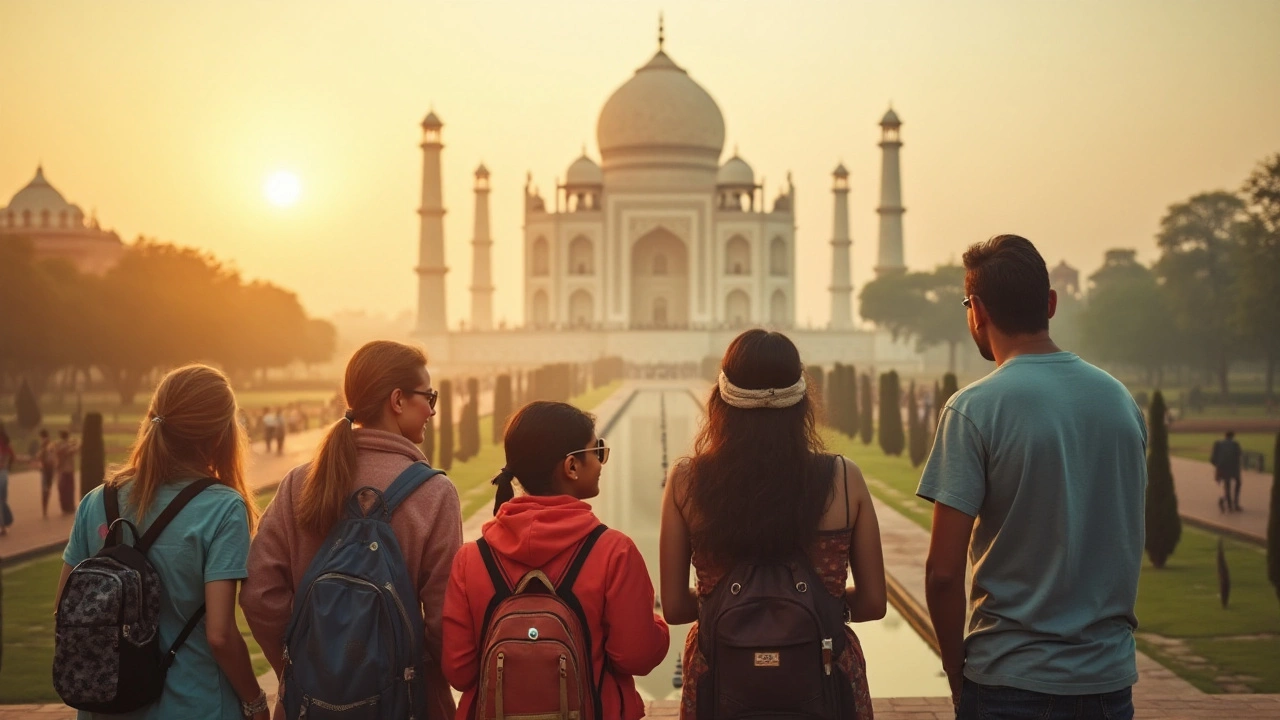India, a land of vibrant hues and deep-seated traditions, has swiftly become a magnet for American tourists seeking cultural enrichment. The country, with its ancient temples and bustling bazaars, offers a rich tapestry of history, spirituality, and art that beckons travelers from all walks of life. For Americans eager to dive into a world steeped in time-honored customs and mesmerizing rituals, India presents an enticing adventure.
From the architectural marvels like the majestic Taj Mahal to the holy city of Varanasi where life and spirituality converge, each destination in India reveals a new layer of the country's intricate cultural fabric. Tourists often find themselves amazed by the diversity in festivals; whether it’s the electrifying chaos of Holi or the dazzling lights of Diwali, there's a celebration for every season.
To truly embrace what India has to offer, travelers are encouraged to go beyond the well-trodden paths. This means savoring regional dishes, conversing with locals, and perhaps most importantly, embracing the unpredictability of Indian life. For American visitors, this journey is about more than just sightseeing—it's about experiencing the heart and soul of a nation where ancient and modern worlds seamlessly coexist.
- The Allure of India's Cultural Heritage
- Historic Landmarks and Monuments
- Spiritual Journeys and Pilgrimages
- Festivals and Celebrations
- Tips for Immersive Travel Experiences
The Allure of India's Cultural Heritage
To understand the magical pull of India on American tourists, one must dive into the depths of its multifaceted cultural heritage. Home to an ancient civilization, India boasts a tapestry that stretches back thousands of years, offering a kaleidoscope of artistic traditions, languages, and philosophies. From the intricate carvings of Ajanta's rock-cut caves to the classical dance forms like Bharatanatyam and Kathak, the country promises an enriching experience that appeals to every sense. It's no wonder that travelers find themselves entranced by the spirituality infused within India's cultural practices, with rituals and customs that hold as much meaning today as they did centuries ago.
The vibrant sounds and sights are just the beginning. Take, for example, the classical Indian music, which transcends mere notes to create a sacred experience, resonating across time; its roots trace back over 2000 years. The allure of India also lies in its extraordinary architecture: structures like the Sun Temple in Konark and the palatial forts of Rajasthan stand as testaments to the ingenuity of ancient builders. These are not just grand edifices but are storied keepers of the country's lineage, offering an insightful glimpse into the past.
Former U.S. President Barack Obama once remarked on the heart of India, calling it a "land of astounding diversity."
Cultural tourism in India allows Americans to experience deeply personal connections with the land’s storied heritage. They explore cities like Kolkata, known for its colonial influence and literary richness, or Mumbai, with its fast-paced life and Bollywood dreams. Yet, beyond urban landscapes, rural India offers its own lessons—villages where generations have preserved their unique ways of life contribute just as much to the country's allure. It's this blend of the ancient and the new, of harmony amidst diversity, that has travelers wishing to return time and again.
Not just limited to monuments and art, India's cultural wealth is entrenched in its traditions. From the ancient practice of yoga to the meditative philosophy of Ayurveda, the country's cultural practices offer paths to both physical and spiritual well-being. Festivals such as the Ratha Yatra and Pongal present visitors with the opportunity to witness and partake in celebrations that are as joyful as they are traditional. For those looking to delve even deeper, there are stories from great epics like The Ramayana and Mahabharata, tales that have shaped the ethics and artistic expressions of the region.
Ultimately, the appeal of India’s cultural heritage lies in its ability to engage and enrich anyone who ventures into its embrace. More than just a visitor, each traveler to India becomes a part of a continuing narrative that bridges the past with the present. This nation, steeped in age-old wisdom yet brimming with youthful energy, offers a lesson in co-existence and transformation. For American tourists, exploring India's cultural landscape is akin to undergoing a rite of passage, a journey that invites introspection and celebrates diversity.
Historic Landmarks and Monuments
For American tourists venturing into India, the country's historic landmarks and monuments often take center stage. These majestic structures tell stories of eras long gone, echoing the footsteps of emperors, artisans, and ordinary folk who breathed life into these places. One cannot discuss Indian landmarks without mentioning the awe-inspiring Taj Mahal. Built by the Mughal emperor Shah Jahan in memory of his beloved wife Mumtaz Mahal, this glistening white marble mausoleum stands as a testament to eternal love. The Taj Mahal’s intricate carvings and its reflection against the Yamuna River during sunrise are sights that leave visitors mesmerized.
While the Taj Mahal might be the headline act, many other historic sites in India also have compelling tales to tell. In the heart of Rajasthan lies the Amer Fort, a stunning amalgamation of Hindu and Mughal architecture. As American tourists walk through its sprawling courtyards, they can almost hear the echoes of ancient courtly life. The fort’s light and sound show, held nightly, narrates the opulent history, leaving many spellbound by its past.
“Visiting these landmarks gives you not just a sight to behold but an experience that transcends time. The history seeps through every stone,” remarked an article in National Geographic.
No journey through India's history would be complete without a visit to the Qutub Minar in Delhi. As the world's tallest brick minaret, it stands as a landmark to the start of Muslim rule in India. Constructed in the 13th century, the Qutub Minar is both a feat of engineering and an artful bout of imagination, with its detailed carvings telling stories of the era’s craftsmanship and ambition.
American tourists often comment on the depth of history embedded within these stones and the complex narratives they uphold. This is why the allure of monuments such as the Ajanta and Ellora Caves is irresistible. These caves, with their exquisite murals and statues, depict scenes from the life of Buddha and are a UNESCO World Heritage Site. As visitors move from one cave to the next, they are transported back to a time when art was the language of faith and expression.
For those drawn to the military rigor and architectural might, the Red Fort in Delhi offers a glimpse into India’s cherished past. Once the main residence of the Mughal emperors, this fort has witnessed centuries of history, including India's struggle for freedom. Its imposing walls tell tales of battles fought and won, while the interiors mesmerize with their blend of Persian, Timurid, and Hindu architectural styles.

Spiritual Journeys and Pilgrimages
In the land where spirituality intertwines with daily life, many American tourists find themselves drawn to India's revered pilgrimage sites. These journeys offer a profound way of exploring not just the physical landscape, but also the rich spiritual nuances that define India. The Ganges River, considered sacred by millions, is often at the top of the list for those seeking a spiritual awakening. Varanasi, one of the world's oldest cities, presents a unique blend of chaos and tranquility, offering sunrise boat rides along the river where you can witness daily rituals that have remained unchanged for centuries. Many travelers describe this experience as both humbling and enlightening.
Sikhism's Golden Temple in Amritsar is another pinnacle of spiritual journeys in India. With its shimmering gold façade standing proudly in the midst of a sacred pool, the Harmandir Sahib welcomes visitors from all over the world, offering a glimpse into the devout Sikh tradition of service and community. The temple complex not only serves as a site for prayer and reflection but also operates one of the largest free community kitchens, feeding thousands of visitors daily—an embodiment of charity and equality.
In the foothills of the Himalayas, Rishikesh beckons seekers of peace and introspection. Known as the yoga capital of the world, Rishikesh is famous for its ashrams and meditation centers. It is a place where ancient teachings of yoga are not just preserved but practiced with the same fervor that attracted the Beatles in the 1960s, leaving a lasting cultural impact. Whether you're attending a yoga retreat or simply walking across the pedestrian suspension bridges over the Ganges, Rishikesh offers a serene environment for reflection and personal growth.
The spiritual heartbeat of India extends to the south as well, where the towering temples of Tamil Nadu stand as testaments to an enduring devotion that spans centuries. Madurai’s Meenakshi Amman Temple, with its towering gopurams adorned in myths and legends, is a marvel of architectural spirituality. Here, the air is thick with the scent of incense as worshippers conduct ancient rituals that have been carried forward through generations—inviting visitors to witness practices that transcend the ordinary passage of time.
It's been said by Mahatma Gandhi, "The essence of all religions is one, only their approaches are different." This unity within diversity can be palpably felt across India's spiritual landscape, resonating with those who journey in search of deeper meanings. For American tourists on these pilgrimages, it's a chance to engage deeply with the philosophies and practices that speak to the universal search for meaning and connection. It’s not just the destinations themselves, but the collective energy of these sacred sites that transform any visit to India into an unforgettable spiritual odyssey.
Festivals and Celebrations
One of the most captivating aspects of visiting India for American tourists is the opportunity to partake in its exuberant festivals and dazzling celebrations. India boasts a calendar filled with colorful festivals that reflect its deep-set cultural diversity. Each festival presents its own set of unique customs and rituals, often serving as a gateway to understanding the country's vibrant social tapestry. Whether it's the spirited Holi festival or the serene Diwali, every celebration is wrapped in stories and traditions that have been cherished for centuries.
Holi, known as the festival of colors, is among the most anticipated events by locals and tourists alike. This spring festival, usually celebrated in March, signifies the victory of good over evil and the arrival of spring. Streets are transformed into vibrant canvases where people douse each other in colored powders and water. Music blares, sweets are shared, and there’s an unrestrained sense of joy that’s infectious. Many travelers recount their Holi experience as transformative, offering a glimpse into the communal spirit and zest for life that epitomizes India.
Diwali: The Festival of Lights
Diwali, another major festival celebrated across the country, marks the triumph of light over darkness. Celebrated over five days, this festival sees homes adorned with lamps, candles, and decorative lights, creating a breathtaking spectacle. Each region in India has its own unique customs during Diwali, but the common thread is the emphasis on light and fellowship. Americans visiting at this time can witness the explosion of fireworks across the night sky and the warmth of family gatherings. A traveler once remarked, "During Diwali, everything is celestial, the lights, the warmth, the harmony—it connects you with the divine," capturing the profound aura of this celebration.
Festivals such as Durga Puja, celebrated predominantly in West Bengal, or Ganesh Chaturthi in Maharashtra, further highlight the regional diversity within India. These festivals not only hold religious significance but also showcase India's artistic and culinary excellence. During Durga Puja, elaborately crafted idols and artistic pavilions, known as pandals, become focal points of artistic expression, drawing lakhs of visitors. Travelers can savor festival-special foods, witness dance performances, and soak in the electric atmosphere that these celebrations create.
To make the most of these celebrations, it’s wise to plan travel around the festival dates and consider staying with a local family or participating in organized tours that provide contextual understanding and guided access to festival activities. Whether it's breaking stereotypes, embracing chaos, or finding tranquility in the midst of festivities, for American tourists, India's festivals offer memories that last a lifetime. An Indian saying wisely notes,
"To know India and her rich culture, dive into her joyous festivals; she reveals all with color and life."
| Festival | Month | Region |
|---|---|---|
| Holi | March | Nationwide |
| Diwali | October/November | Nationwide |
| Durga Puja | September/October | West Bengal |
| Ganesh Chaturthi | August/September | Maharashtra |

Tips for Immersive Travel Experiences
When embarking on a cultural tourism adventure in India, diving deep into the experiences that truly define the essence of the country is key. For American tourists looking to make the most out of their journey, integrating into the local way of life can offer a perspective that's both enlightening and transformative. Start by prioritizing interaction over mere observation. Strike up conversations with locals, who are often eager to share their stories and traditions, offering insights that can't be gleaned from guidebooks. Embrace the diversity of the cultural tourism scene by trying your hand at regional crafts, taking part in traditional cooking lessons, or participating in community-led tours, which are increasingly popular among Americans visiting India.
An understanding of local customs and etiquettes can significantly enhance your experience, avoiding unwarranted faux pas that may arise from cultural misunderstandings. It’s not just about visiting the landmark sites but doing so with an informed appreciation of their history and significance. Consider hiring guides who are not just knowledgeable but also passionate about their heritage; sometimes, their personal anecdotes add a layer of depth that enriches the entire visit. Embarking on spiritual journeys, whether through urban centers or rural retreats, can also provide profound moments of reflection and connection. Christianity, Islam, Hinduism, Buddhism, and countless other faiths coexist in India, offering a kaleidoscope of beliefs that invite contemplation and exploration.
The vibrancy of India's festivals presents an unparalleled opportunity to witness the country's joyous spirit in full swing. Being part of the Holi festival, known for its riot of colors, or Diwali, the festival of lights, allows tourists to blend into the exhilarating chaos that defines India's festive landscape. Seasonal events offer chances to witness authentic rituals and local folklore. As you traverse different regions, let your taste buds guide you. Sample the local cuisine, from the spicy allure of Rajasthani dishes to the subtle flavors of Kerala's fare. These culinary adventures are not just about taste; they reflect historical influences and regional diversification.
For a deeply immersive experience, explore less-treaded paths. Move beyond the confines of popular circles to find majestic serene backwaters, remote temples nestled in the heart of nature, or bustling villages where time seems to have stopped. Such ventures often yield the most rewarding experiences. The presence of eco-friendly accommodations and community-run initiatives has increased noticeably, with diverse options suited to different budget ranges. These offer enriching stays and ensure that your visit contributes positively to the local communities. An effective approach can involve alternating between city explorations and rural retreats, achieving a balanced view of India's vast cultural landscape.
"Travel is fatal to prejudice, bigotry, and narrow-mindedness, and many of our people need it sorely on these accounts." - Mark TwainTo embrace India fully, maintain an open mind and be prepared for unpredictability. The enigmatic chaos of India often baffles first-time visitors, but it is precisely this unpredictability that renders each experience unique. Adaptability is crucial, for the nuances of this sprawling nation can be most beautifully experienced in real-time, often leading to unforgettable memories that cherish the fluid beauty of the country. This approach is invaluable for those keen to absorb not just the sights, but the spirit of India itself.
